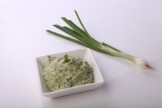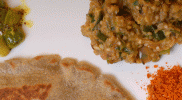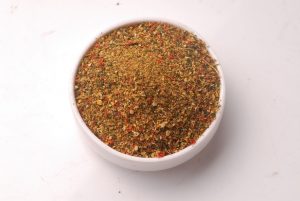Beet root is a part of the regular meal in the Southern Indian states, Tamil Nadu and Ker...
Sorrel Leaves And Coconut Chutney is a famous chutney in the state of Andhra Pradesh. S...

Spring Onion Chutney is exceptionally yummy and subtly spiced chutney which can also be e...
Sweet and sour bitter gourd pickle is a delicious Indian recipe served as a side dish.310...

Vangyachi Barith is a yummy dish made from roasted eggplant and spices. It is otherwise a...
Chutney made from raw papaya in south Indian style is one of the most had recipes....
Methi leaves can be used to make a chutney which goes well with rice or with any breakfast like idli, dosa, pesarattu and uttapam.

Methi leaves podi is an excellent chutney Read More..
About Recipe
Meth koora pachadi, Venthia keera karathuvaiyal, Methisag Chatni |
|||||||||||||||||||||||||||||||||||
|
|||||||||||||||||||||||||||||||||||

Methi leaves podi is an excellent chutney spice mix powder, is a mix of fenugreek leaves or methi leaves, coriander seeds, dals, red chillies, cumin seeds ,tamarind and garlic. Methi leaves podi is highly flavorful, spicy to taste, garlicky, earthy zest from cumin and coriander seeds, tanginess of the tamarind, wonderful crunchiness from the dals and the slight bitterness from the methi leaves offers a striking feel on the palate while eating.
Podis are dry powders made with spices, dals and other ingredients like curry leaves or dried herbs like coriander and mint. While some podis like Gun Powder (Milagai Podi) are served as dry chutney with Idli, Dosa and Uttapas, can also be served with hot rice and til oil.
Methi is a very popular green herb which is also commonly known as fenugreek leaves in English, menthya in Kannada, menthe akulu in Telugu. Fenugreek is grown throughout South Asia. It has a distinct taste and smell. It is native to the Middle East. Fenugreek is also an ancient spice, mostly used in pickles. Dry roasting enhances its flavour and reduces its bitterness.
Fenugreek are used in making a lot of dishes in India. Some of the popular dishes prepared in Indian cuisine are Methi Chicken, Methi Chaman, Methi Paratha etc. In Indian cuisine, we use both the leaf and the spice as it has a slight sweet and bitter taste. it is used as one of the main ingredients in curry powder or to flavour spiced vinegar.
Fenugreek is used both as an herb (the leaves) and as a spice (the seed). It is cultivated worldwide as a semi-arid crop and frequently used in curry. It is a very popular herb cooked in the major sub-continental region of India and Pakistan, usually together with potatoes and/or spinach, and eaten with Roti or Naan(flatbread) and/or rice. It is usually eaten boiled in China, and Central and Western Asia. Major fenugreek producing countries are India, Pakistan, Bangladesh, Argentina, Egypt, France and China.
India is the largest producer of the fenugreek in the world and northern states of India like the Rajasthan, Gujarat, Uttaranchal, Uttar Pradesh, Madhya Pradesh, Maharashtra and Punjab are the major producing states of fenugreek. Green Vegetables is one most vital ingredient that we need to include in our meal. Indian cuisine is popularly known for using a wide variety of green vegetables in their cooking.
Prepartion tips:
Health tips:
Methi leaves podi is an excellent chutney spice mix powder which goes well with rice or any South Indian breakfast foods like Idli, Vada, Dosa, Pesarattu, Uttappam or Upma.
Enjoy Cooking and always remember that: “VahrehVah is all about inspiring others to cook”!




Vidya Sagar Posted on Wed Mar 23 2016
Can this be made with Palak leaves instead of Methi??
Reply 0 - Replies
Vidya Sagar Posted on Wed Mar 23 2016
Maam, I am also a Telugu guy...when I was very young...With idly, my mom mad something with Curry leaves...And one with Coriander...they were both podi's. I remember her calling it Kothimiri kharam...and the other, karuvepaku...something...Now sh
Reply 0 - Replies Easy recipes
Easy recipes
 Healthy Recipes
Healthy Recipes
 Dessert Recipes
Dessert Recipes
 Mutton and Lamb
Mutton and Lamb  Indian Bread Recipes
Indian Bread Recipes
 Dal Recipes
Dal Recipes
 Chutney and Pickles
Chutney and Pickles  Indo-Chinese Recipes
Indo-Chinese Recipes
 Snacks and Appetizers
Snacks and Appetizers
 Low Fat Recipes
Low Fat Recipes
 Chaat Recipes
Chaat Recipes
 Biryani and Rice
Biryani and Rice  Curry Recipes
Curry Recipes
 Indian Sweet Recipes
Indian Sweet Recipes
 Egg Recipes
Egg Recipes
 Paneer Recipes
Paneer Recipes
 Chicken Recipes
Chicken Recipes
 Indian tiffins
Indian tiffins
 Egg less Recipes
Egg less Recipes
 Soups and Salads
Soups and Salads
 Indian Sea Food
Indian Sea Food
 Manchurian Recipes
Manchurian Recipes
 Indian Drinks Recipes
Indian Drinks Recipes
 Dinner Recipes
Dinner Recipes
Rahmat Begum Posted on Sat Mar 19 2016
Now, this is something new! I'm not sure I can get this Methi leaves in my country. Can I replace the fresh leaves with the dried pre-packed leaves??
Reply 0 - Replies